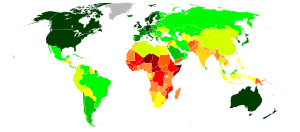মানব উন্নয়ন সূচক
মানব উন্নয়ন সূচক (ইংরেজি: Human Development Index) বিশ্বের সকল দেশসমূহের জীবন ধারণের মান, শিক্ষা, নিরক্ষরতা প্রভৃতির একটি তুলনামূলক সূচক। এখানে বিভিন্ন ধরনের পরিসংখ্যান ব্যবহার করে "মানব উন্নয়নের" মাপকাঠিতে সংশ্লিষ্ট দেশগুলোকে ক্রমানুসারে সাজানো হয় এবং "অনেক ভাল মানব উন্নয়ন", "ভাল মানব উন্নয়ন", "মাঝারি মানব উন্নয়ন" ও "নিম্ন মানব উন্নয়ন" এইসব ভাগে ভাগ করা হয়।

|
> ০.৯৫
০.৯০-০.৯৪৯
0.85-0.899
0.80-0.849
0.75-0.799
0.70-0.749 |
0.65-0.699
0.60-0.649
0.55-0.599
0.50-0.549
0.45-0.499
0.40-0.449 |
0.35-0.399
0.30-0.349
< 0.30
N/A |
মানদণ্ড
জাতিসংঘ মানব উন্নয়ন সূচকে পরিসংখ্যানগতভাবে কোন দেশের মানব উন্নয়ন সংক্রান্ত তথ্যাদি তুলে ধরে। উচ্চমাত্রার মানব উন্নয়ন সূচকের সাথে উন্নত দেশের ভবিষ্যতের অর্থনীতির গতিধারা গভীরভাবে সম্পর্কযুক্ত। সেখানে একটি দেশের আর্থিক আয় কিংবা উৎপাদনশীলতার চেয়ে অন্যান্য বিষয়াদির উপর ব্যাপক গুরুত্বারোপ করা হয়। মাথাপিছু মোট অভ্যন্তরীণ উৎপাদন কিংবা মাথাপিছ আয়ের পাশাপাশি আয়ের কতটুকু অংশ শিক্ষা এবং স্বাস্থ্যখাতে ব্যয়িত হয়েছে তা-ও তুলে ধরা হয়।
১৯৯০ সাল থেকে নরওয়ে, জাপান, কানাডা এবং আইসল্যান্ড সর্বোচ্চ মানব উন্নয়ন সূচকে স্থান পেয়েছে। ২০১১ সালের মানব উন্নয়ন প্রতিবেদন ২ নভেম্বর, ২০১১ সালে প্রকাশিত হয়। এতে উচ্চমাত্রার মানব উন্নয়ন সূচকে ৪৭টি দেশ স্থান পায় যাতে সর্বোচ্চ ০.৯৪৩ স্কোরে নরওয়ে এবং ০.৭৯৩ স্কোরে বার্বাডোজ জায়গা করে নেয়।[1]
দিকসমূহ ও গণনা পদ্ধতি
২০১০ সালের ৪ নভেম্বর প্রকাশিত হওয়া অনুযায়ী তিনটি দিক বিবেচনা করা হয়েছে।
- দীর্ঘ ও সুস্বাস্থ্যকর জীবন: জন্মের সময় জীবন প্রত্যাশা
- শিক্ষা সূচক: বিদ্যালয় যাওয়ার গড় বছর ও বিদ্যালয়ে যাওয়ার আনুমানিক বছর
- জীবন ধারণের মান: জনপ্রতি মোট রাষ্ট্রীয় উৎপাদন
গণনা করার উপায়
- জীবন প্রত্যাশা সূচক(LEI):
LE(Life Expectancy)- জীবন প্রত্যাশা
LEI-Life Expectancy Index
জন্মের সময় জীবন প্রত্যাশা ৮৫ হলে জীবন প্রত্যাশা সূচক ১ হবে এবং জন্মের সময় জীবন প্রত্যাশা ২০ হলে জীবন প্রত্যাশা সূচক হবে ০।
- শিক্ষা সূচক(EI): [2]
EI- Education Index
- 2.1 বিদ্যালয়ে যাওয়ার গড় বছর সূচক(MYSI): [3]
২০২৫ সাল পর্যন্ত এই সূচকটির উচ্চমান ১৫ ধরা হয়েছে।
- 2.2 বিদ্যালয়ে যাওয়ার আনুমানিক বছর সূচক(EYSI): [4]
- MYSI(Mean Year of Schooling Index)- বিদ্যালয় যাওয়ার গড় বছর সূচক
- EYSI(Expected Year of Schooling Index)- বিদ্যালয় যাওয়ার আনুমানিক বছর সূচক
3. আয় সূচক(II): II- Income Index
জনপ্রতি মোট ঘরোয়া উৎপাদন ৭৫০০০ ডলার হলে আয় সূচক হবে ১ এবং ১০০ ডলার হলে আয় সূচক ০ হবে।
মানব উন্নয়ন সূচক হল ওপরের সবকটির সূচকের গুণোত্তর প্রগতি
তথ্যসূত্র
- http://hdr.undp.org/en/media/HDR_2011_EN_Table1.pdf 2011 Human Development Index
- "New method of calculation of Human Development Index (HDI)"। India Study Channel (ইংরেজি ভাষায়)। ২০১১-০৬-০১। সংগ্রহের তারিখ ২০১৭-১১-১৯।
- Mean years of schooling (of adults) (years) is a calculation of the average number of years of education received by people ages 25 and older in their lifetime based on education attainment levels of the population converted into years of schooling based on theoretical duration of each level of education attended. Source: Barro, R. J.; Lee, J.-W. (২০১০)। "A New Data Set of Educational Attainment in the World, 1950–2010"। NBER Working Paper No. 15902।
- (ESYI is a calculation of the number of years a child is expected to attend school, or university, including the years spent on repetition. It is the sum of the age-specific enrollment ratios for primary, secondary, post-secondary non-tertiary and tertiary education and is calculated assuming the prevailing patterns of age-specific enrollment rates were to stay the same throughout the child's life. Expected years of schooling is capped at 18 years. (Source: UNESCO Institute for Statistics (2010). Correspondence on education indicators. March. Montreal.)